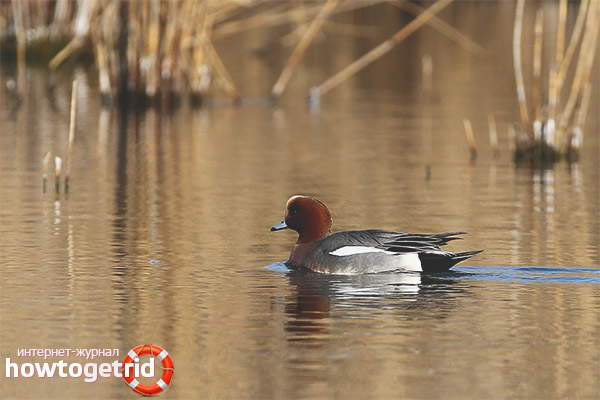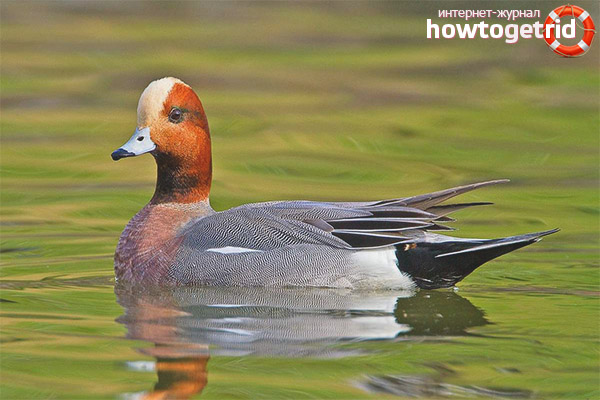The content of the article
One of the most famous northern feathered breeds is the heel. Often it is called sviyaga, whistler or swish. By its name, the duck owes its own ability to make whistle-like sounds.
The bird lives in the northern forest-steppe and forest-tundra zones, and during the wintering season it travels to the warm regions - East Africa and South Asia, as well as Indochina. Sviyazi form numerous flocks, so it is very rare to meet such a bird separately. In some cases, a flock may include up to several thousand birds. Sviyazi gather in marshy areas, in fields or wet meadows.
External description duck
The appearance of the sviyazi drake is very static and beautiful, the head is painted in chestnut, there is a strip of golden color, the abdomen is gray-white, and the chest is painted in red-gray. Above, the bird has a gray plumage, and the sides and tail are black.
The wing below has small feathers, which are called a “mirror”. They shimmer with greenish-lilac shades, and white spots on the shoulders add a twinkle of beauty and pride.
The beak of the bird is colored blue, the border is black, and the limbs are gray. As for the females, their plumage is more modest - it is reddish-gray tones that allow them to hide effectively and protect the offspring.
Special duck voice
Even at a sufficiently large distance, one can often hear the call of the wig, and due to this they can be distinguished from many other species of migratory birds. An interesting fact is that the duck and the drake emit different sounds. In normal times, males have a soft voice, making smooth and long sounds “sv-i-u” or “pi-and-u”, vaguely reminiscent of the whistle or that sound made by a squeaker in children's toys.
During the mating period, the voice of representatives of this species of birds changes, special notes and sounds are mixed with it. The drake begins to call the female sviyazi, making the sounds “svi-i-iu” or “frr-i-i-u”. Ducks respond to such a call with a slightly dull quack, similar to the sound "kerrrr".
Features of breeding
Wild ducks can mate and create offspring in the first year of their life. In some situations, females do not start breeding, while waiting for the upcoming summer. This results in the fact that some pairs of bundles are formed in the autumn, when the flock goes to the southern edges, and the rest is already during the flight. Often, wild ducks can return to their nest in already folded pairs.
Mating games among representatives of this breed are particularly modest and “innocent,” without any characteristic features and manifestations. Drains the vast majority of the time are close to the female, demonstrating to all other males that the duck is already occupied. During mating games, ducks begin to make specific sounds that are most similar to a deafeningly loud whistle, which is why the breed is called that way.
Sviyazi pick up cozy places somewhere in the thickets of shrubs left over from last year. The female duck begins to build a nest in a small hole, using, among other things, its fluff. And for a month and a half until half of June, the duck begins to lay eggs. Usually in one clutch there can be an average of up to eight eggs.
At first, the drake spends time near the female, but then flies away for the period during which molting occurs. Males at this moment are located on Siberian lakes, in the deltas of the Urals or Volga.
Hatching eggs takes approximately 24-26 days. Some time after the appearance of the chicks, they dry out and can be sent for the female. Their ears and eyes are already open, they can swim in the water and run, looking for their own food. By the age of 45 days, chicks can usually fly. By that time, the brood begins to gradually disintegrate. The flock will be gathering closer to the end of August, when it is time to go for the winter.
Sviyaz mostly lives in Russia, Finland, in the territory of the North. Caucasus and Scandinavia. In addition, they can be found in the edges of Iceland and the islands located near the Arctic. A large population is located in the Baikal region, near the Sea of Okhotsk and in Kamchatka.
When a duck chooses a place for nesting, it first draws attention to small reservoirs in which the bottom is covered with silt. An indispensable condition in this case will be the presence of aquatic herbs and vegetation in large volumes, which will allow wild ducks to feel a certain safety. It is for this reason that wilderness can be seen in secluded backwaters, in marshy areas or in forest lakes.
In winter, representatives of this breed of birds gather in numerous flocks, heading to the warm southern bays and distant estuaries. Usually this is the territory of Western Europe, Asia, areas of the Mediterranean.
Vegetarian Birds

Squid can eat only plant foods. They can find food for themselves, not only in the water, but also on the coastal zones, pinching plants. For the most part, the diet of wild ducks consists of the following elements:
- shoots of plants;
- leaves;
- various herbs;
- cereals;
- marsh duckweed;
- seeds;
- roots of aquatic vegetation or bulbs.
Interesting Facts About Sviyaz
A wild duck does not have much love for diving, but often its diet includes lush grass stems and roots that grow at the bottom of rivers. Being pretty smart birds, they often use outside help without bothering to sink to the bottom. Sometimes the wiggle can be seen next to the swans, where the ducks are satisfied with the remnants of food from the water surface.
Shedding in this species of birds takes quite a lot of time, but during this period the wig retains the ability to fly. This becomes possible due to the fact that feathers, which are fly-like, fall out of the duck gradually, over time, so new ones already have time to grow. On average, a duck can live up to 15 years if it lives at home, in an aviary. In vivo, a rare duck can live for more than 3-4 years. This bird has tremendous industrial value.
Video: Squire (Anas penelope)











Submit